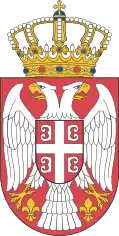Poland–Serbia relations
Polish-Serbian relations are foreign relations between Poland and Serbia. Diplomatic relations have been maintained since Poland and the Kingdom of Serbs, Croats and Slovenes established them in 1919. Poland is a European Union member state and Serbia is a European Union candidate.
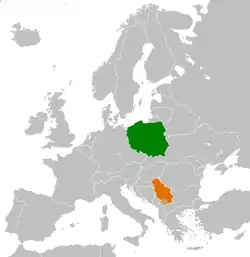 | |
Poland |
Serbia |
|---|---|
Middle Ages

Queen Jadwiga of Poland (r. 1384–99) had partial Serbian ancestry, through King Stefan Dragutin (r. 1276–82) of the Nemanjić dynasty.[1] Serbian fiddlers (guslars) were mentioned at the court of Polish king Władysław II Jagiełło (r. 1386–1434) in 1415.[2][3]
Polish knight Zawisza Czarny, who joined Hungarian–Bohemian King Sigismund's war against the Ottomans, fell at the Golubac fortress in eastern Serbia in 1428;[4] there is a commemorative plaque on the fortress in his honour (Česma Zaviše Crnog).[5] Hungarian commander John Hunyadi led a long campaign against the Ottomans in 1443–44, accompanied by Polish king Władysław III, Serbian despot Đurađ Branković, Wallachian voivode Vlad II Dracul, and a Polish contingent. They marched throughout Serbia and defeated the Ottomans at Niš.[6]
The Polish hussars (cavalry) originated in mercenary units of exiled Serbian warriors,[7] the concept having originated in Serbia in the late 14th century. The oldest mention of hussars in Polish documents date to 1500, although they were probably in service earlier.[8]
Early modern history
After the Ottoman conquest of Serbia, Serbian guslars (fiddlers) found refuge throughout Europe, as mentioned in sources.[9] Polish poets of the 17th century mentioned Serbian epic poetry and the gusle in their works. In a poem published in 1612, Kasper Miaskowski wrote that "the Serbian gusle and gaidas will overwhelm Shrove Tuesday" (Serbskie skrzypki i dudy ostatek zagluszą).[10] In the idyll named Śpiewacy, published in 1663, Józef Bartłomiej Zimorowic used the phrase "to sing to the Serbian gusle" (przy Serbskich gęślach śpiewać).[10][11]
Modern history
19th century
After the November Uprising (1830–31), Polish revolutionaries fled to the Principality of Serbia. Serbian commander, and later politician, Ilija Garašanin (1812–1874) contacted these Polish emigrees. It was a Pole, Adam Czartoryski, who initiated the Načertanije project (the precursor to Greater Serbia).[12] While in 1804, during his mandate as a Russian foreign minister, Czartoryski tended to dismiss what he perceived as Serb ambitious requests, he later substantially changed his view when as one of the exiled Polish leaders he perceived the Principality of Serbia as the key member of the future anti-imperialist (Austrian and Russian) aliance of small European states.[13]
The great Polish poet Adam Mickiewicz (1798–1855) thought highly of Serb epic poetry, and chose it as a theme of lectures at Collège de France.[14]
The Serbians and Poles were part of the Pan-Slavic Sokol organizations, along with other Slavic nations.[15]
World War I
In March 1914, Serbian, French, Polish and Greek allied troops landed at Odessa.[16] In the early fall of 1918, an Allied account said that Serbs and Poles in a region from the Urals to Volga had been recruited by a French officer.[16] In 1918, Serbs and Poles together with Chinese, were part of the "Officer's Corps", a unit of the Russian Consul at Harbin.[16]
World War II
Serbs and Poles were some of the major Slavic victims of Nazi German war crimes in Europe. Nazi Germany considered all Poles and Serbs as Untermensch, meaning "subhumans". Many ethnic Poles and ethnic Serbs died in concentration camps, or during retaliative guerrilla fights. Poles joined the Yugoslav Partisans in the beginning of the war. Yugoslav Partisans were often compared to the Polish Underground State and the Polish Resistance Movement which was the largest anti-Nazi guerrilla movement in all of German-occupied Europe. Ethnic Serbian prisoners of war were among Allied POWs held in German POW camps operated in occupied Poland.
In the mountains of Serbia in the years 1942–43 there were three Polish companies attached to the Chetnik Corps.[17] The Rules of Chetnik Warfare was first published in Polish, then translated into Serbian.[18]
On 1 June 1944, a Balkan Air Force was established by the British. It had mostly British, but also Italian, a Yugoslav squadron, and a Polish flight.[19]
2022
A large number of terrorist threats sent to Serbia from Poland occurred in year 2022, which targeted schools, hospitals, dormitories, museums, stadiums, embassies, shopping malls, water plants, planes and more.[20][21] Serbian president claimed that one EU country secret service is involved.[22] Polish side didn't try to catch those responsible. Two Polish citizens were arrested for filming Serbian arms factory Sloboda.[23]
Politics
April 15, 2010, was declared a day of national mourning in Serbia to commemorate the 96 victims of the Smolensk air disaster, including Polish President Lech Kaczyński and his wife Maria Kaczyńska.[24]
In November 2021, Poland donated 200,000 COVID-19 vaccines to Serbia.[25]
Kosovo
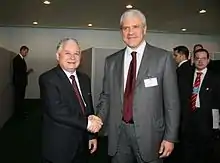
Polish opinion on NATO intervention in FR Yugoslavia during the Kosovo War (1998–99) was mixed: 37% favoured involvement while 43% were against. The government decided in favor of a NATO-led operation to bring cease-fire in the conflict. During the NATO bombing of Yugoslavia in May 1999, a poll found 51% felt attacks to be justified, 26% opposed. Another poll found 53% in favour and 35% opposed.[26]
Kosovo declared its independence from Serbia on 17 February 2008 and Poland recognized it on 26 February 2008.[27] Poland was the first Slavic country to do so.
In September 2008, President of Poland, Lech Kaczyński, stated that the original cause of the 2008 South Ossetia war was not the Georgian operation, but the recognition of Kosovo's independence[28] and that he would block attempts to establish diplomatic relations of Poland with Kosovo at ambassadorial level; however, the government has not proposed to send an ambassador to Pristina.[29]
The recognition of Kosovo Albanian independence has been criticized in Poland. Dozens of protests and demonstrations have been organized by various groups in Poland in support of the Serbian cause in Kosovo, with some attracting up to 1,500 to 2,000 people. An organization called "Poles for Serbian Kosovo" was formed in order to provide and support for Serbs in Kosovo. Also Poland is an EU member and Serbia is an EU candidate.
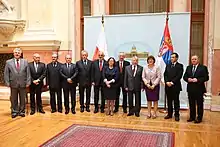
Peacekeeping
Poland had (as of July 2009) 274 troops serving in Kosovo as peacekeepers in the NATO-led Kosovo Force. Originally there were 800 Polish troops in KFOR.[30]
Cultural relations
The Polish and Serbian languages, both part of the Slavic languages (West and South branches, respectively), are related and partially mutually intelligible.[31][32]
Due to huge popularity of the Yugoslav rock scene in Poland in the 1970s and 1980s, many Yugoslav artists toured Poland. Električni orgazam recorded a live album titled Warszawa "'81'" to support the Polish opposition against Wojciech Jaruzelski.[33] These connections in the 1980s led to albums being produced in Poland based on covers of popular Serbian and Yugoslav Rock bands with the albums Yugoton and Yugopolis covering artists such as Bajaga i Instruktori, Idoli and Električni orgazam.
The Kayah i Bregović-album by Polish singer-songwriter Kayah and Serbian musician Goran Bregović became a bestseller after its release in 1999.[34]
Poles in Serbia
There are documents on Polish officers participating in the First Serbian Uprising (1804-1813). In the second half of the 19th century, especially after the suppression of the January Uprising in Poland (1864), some 20 Polish doctors arrived in Serbia, most of which settled down and gave a great contribution to the development of medical culture in the renewed Serbian state. The League of Yugoslavia–Poland (Liga Jugoslavija-Poljska) was active in the Interwar period, aimed at economical and cultural cooperation with Poland. The League was not a diaspora organization, although it gathered also a small number of Yugoslav Poles at its seat in Uzun–Mirko's Street 5 in Belgrade, especially during national and Catholic holidays. Members of the League helped Polish soldiers and civilians who in autumn 1939 fled from Romania via Yugoslavia to the West. Immediately after World War II some tens of Polish women with their Serbian husbands arrived in Serbia; they had met at forced labor and concentration camps in Germany. The largest part of the Polonia (Polish diaspora) in Serbia is made up of women who married in Yugoslavia in the 1960s and 70s. During the Yugoslav wars, when Yugoslavia broke up, many Polish and their families either returned to Poland or emigrated to the West. According to the Embassy of the Republic of Poland in Serbia, there are around 1,000 Polish citizens living in Serbia. These are individuals born in Poland, as well as their descendants from mixed marriages. Apart from Belgrade, larger numbers exist in Niš, Novi Sad, Kraljevo, Vrnjačka Banja and Subotica. The only community regarded starosedeoci ("natives"), is the one inhabiting Ostojićevo in northern Serbia, having settled in the mid-19th century from the Wisła.[35]
Serbian people of Polish descent
Serbian aviators Tadija Sondermajer and Stanislav Sondermajer, the youngest fighter in the Battle of Cer (1914), were of paternal Polish descent.[36] Serbian officer and journalist Stanislav Krakov (1895–1968) had a father of Polish origin.[37] Journalist and military analyst Miroslav Lazanski is of paternal Polish ancestry.[38] Film director and political commentator Boris Malagurski is of distant paternal Polish ancestry.[39]
Resident diplomatic missions
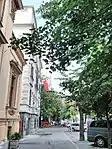 Embassy of Poland in Belgrade
Embassy of Poland in Belgrade Embassy of Serbia in Warsaw
Embassy of Serbia in Warsaw
See also
References
- Oskar Halecki; Tadeusz Gromada (1991). Jadwiga of Anjou and the rise of East Central Europe. Social Science Monographs. pp. 63, 86, 367. ISBN 978-0-88033-206-4.
- Petar Vlahović (2004). Serbia: the country, people, life, customs. Ethnographic Museum. p. 340. ISBN 978-86-7891-031-9.
- Denkschriften. Vol. 58. A. Hölder. 1915. p. 58.
Serbische Geiger werden 1415 am Hofe des polnischen Königs Wladislaw Jagiello genannt.
- Jacek Macyszyn (1 January 2003). Polegaj jak na Zawiszy: mit czy rzeczywistość. Muzeum Wojska Polskiego. p. 309. ISBN 978-83-916229-1-9.
- "Zamek Golubac". Navtur.
- Donald Edgar Pitcher (1968). An Historical Geography of the Ottoman Empire: From Earliest Times to the End of the Sixteenth Century. Brill Archive. p. 73.
- Cathal J. Nolan (2006). The Age of Wars of Religion, 1000-1650: An Encyclopedia of Global Warfare and Civilization. Greenwood Publishing Group. p. 428. ISBN 978-0-313-33733-8.
- Richard Brzezinski (1987). Polish Armies 1569-1696. Osprey Publishing. p. 14. ISBN 978-0-85045-736-0.
- Stana Đurić-Klajn (1972). A Survey of Serbian Music Through the Ages. Association of Composers of Serbia. p. 23.
The Serbian guslars, forced to leave their own country, were often seen and mentioned in foreign countries. According to the chronicles and poems of the Polish poets Miaskowski (1549 — 1622) and Hieronimus Morsztyn (17th century), the Serbian ballad singers went with their gusle from one court to another, enjoying a high reputation, especially in the Ukraine and among the Cossacks of Malorussia. In Hungary, the "Serbian way" of singing was known in many regions
- Krešimir Georgijević (2003). Српскохрватска народна песма у пољској књижевности (in Serbian). Project Rastko.
- Józef Bartłomiej Zimorowic (1857). "Śpiewacy" (in Polish). Kazimierz Józef Turowski, ed. Sielanki Józefa Bartłomieja i Syzmona Zimorowiczów. The Internet Archive. p.39
- Balazs Trencsenyi; Michal Kopecek (1 November 2006). National Romanticism: The Formation of National Movements. Central European University Press. pp. 240–. ISBN 978-963-7326-60-8.
- Dejan Djokić (2023). A Concise History of Serbia. Cambridge University Press. p. 258. ISBN 978-1-107-02838-8.
- Kosta St Pavlović (1943). The struggle of the Serbs. The Standard art book co.
- Pieter M. Judson; Marsha L. Rozenblit (1 January 2005). Constructing Nationalities in East Central Europe. Berghahn Books. ISBN 978-1-57181-176-9.
- Jamie Bisher (2005). White Terror: Cossack Warlords of the Trans-Siberian. Psychology Press. pp. 79, 151. ISBN 978-0-7146-5690-8.
- Stanisław Okęcki (1987). Polacy W Ruchu Oporu Narodów Europy. PWN--Polish Scientific Publishers. p. 301. ISBN 978-83-01-06860-8.
- Tomislav Dulić (2005). Utopias of Nation: Local Mass Killing in Bosnia and Herzegovina, 1941-42. Uppsala University Library. p. 102. ISBN 978-91-554-6302-1.
- Walter R. Roberts (1987). Tito, Mihailović, and the Allies, 1941-1945. Duke University Press. pp. 230–. ISBN 0-8223-0773-1.
- "NOVA DOJAVA O BOMBI U AVIONU ER SRBIJE ZA MOSKVU: Poziv stigao iz Poljske".
- "Chaos in Belgrade: Reports of bomb threats in schools".
- "Vučić: Ukrajina i zemlja EU-a šire lažne dojave o bombama u avionima Air Serbia".
- "Polish Citizens Arrested for Filming "Sloboda" Military Factory". 15 May 2022.
- "U četvrtak dan žalosti u Srbiji zbog pogibije poljskih zvaničnika". Blic.rs (in Serbian). 13 April 2010. Retrieved 5 February 2022.
- "Polska pomoc dla Serbii. Wiceszef MSZ i wicemarszałek Sejmu przekazali 200 tys. szczepionek przeciw COVID-19". PolskieRadio24.pl (in Polish). Retrieved 25 December 2021.
- Mary Buckley; Sally Cummings (2001). Kosovo: Perceptions of War and Its Aftermath. A&C Black. pp. 137–138. ISBN 978-0-8264-5669-4.
- Poland Recognizes Kosovo Archived 2010-04-12 at the Wayback Machine
- Let's First Help Georgia, Then Talk about Russia
- Poland won't open embassy in Priština Archived 2008-09-28 at the Wayback Machine
- "Kosovo Force (KFOR)" www.nato.int Link accessed 21-07-09
- Dale A. Koike; Carl S. Blyth (2015). Dialogue in Multilingual and Multimodal Communities. John Benjamins Publishing Company. pp. 183–. ISBN 978-90-272-6833-4.
- K. M. Petyt (1985). Dialect and Accent in Industrial West Yorkshire. John Benjamins Publishing. pp. 357–. ISBN 90-272-4864-8.
- "A Decades-Long 'Conversation' Between Yugoslav and Polish Rockers". Archived from the original on 11 April 2017.
- "Trzeszcząca płyta". Wprost 24. February 2004.
- Embassy of the Republic of Poland in Serbia. "Poljaci u Srbiji".
- "Rodom Poljaci, ali srcem Srbi". Novosti.
- "Vremeplov: Umro Stanislav Krakov". RTV. 15 December 2012.
- "Istina se plaća" (PDF). Ona magazin. 19 March 2013. Archived from the original (PDF) on 8 December 2015.
{{cite journal}}: Cite journal requires|journal=(help) - „Vítejte v Kosovu, vaše auto je už tady!“ Archived 2015-04-02 at the Wayback Machine Literární noviny
External links
- Serbian Ministry of Foreign Affairs about relations with Poland
- "Poljska za Srbe, Srbija za Poljake". Danas. 20 January 2014.
Further reading
- Đorđe Živanović (1941). "Srbi i poljska književnost (1800-1871)" (in Serbian) (Internet ed.). Beograd: Janus.
- Đorđe Trifunović (1980). "Lesi i leška zemlja u staroj srpskoj književnosti i pismenosti". Zbornik Matice Srpske Za Slavistiku (in Serbian) (Internet ed.). Matica srpska. 21: 59–67.
- Đorđe Živanović (1991). "Poljska emigracija i ponovni izbor Aleksandra Karađorđevića za kneza 1843. godine". Godišnjak Grada Beograda, KNJ (in Serbian) (Internet ed.). Grad Beograd. 38.
- Petar Bunjak (2001) [1999]. "Pregled poljsko-srpskih književnih veza (do II svetskog rata)" (in Serbian) (Dopunjeno i ispravljeno Internet izdanje ed.). Janus; Slavističko društvo Srbije.

